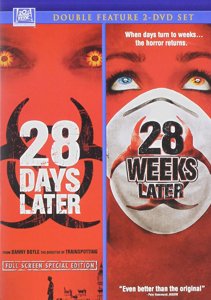“28 Days Later” (2002 in the U.K., 2003 in the U.S.) fast-tracked zombies back into the mainstream for a new century. Director Danny Boyle and writer Alex Garland use Fast Zombies to emphasize the horror of an epidemic. Indeed, these beasts bite and spew blood rather than feasting. (Presumably, they dine on corpses or animals at their leisure, off-screen.)
The filmmaking is epic yet sparse, and it’s hard to say if it’s low-budget or high-budget. It’s shot in low-def to emphasize the apocalypse more so than out of cheapness, I’m sure. Whatever the financial cost, it can’t be easy to achieve wide-angle shots of a London so clearly devoid of anyone except main character Jim (Cillian Murphy).
Boyle’s film starts as a mystery, as hospital patient Jim wakes up to an empty landscape with no police, no military, no TV news, no government … no people. But on the downside, there are zombies.

“28 Days Later” (2002 U.K, 2003 U.S.)
Director: Danny Boyle
Writer: Alex Garland
Stars: Cillian Murphy, Naomie Harris, Christopher Eccleston
Good and bad influences on the subgenre
“28 Days Later’s” action shots of the infected furiously attacking people in an orgy of shaky cameras and quick edits were innovative at the time (and perhaps a way to hide mediocre effects work). But now they are annoying, and they unfortunately influenced other zombie fiction of the era, such as the mainstream “Dawn of the Dead” (2004) remake.
Luckily, Boyle isn’t making an action film, so this is a small percentage of the runtime. When we move away from the close-up attacks to wider angles, we get an appropriate sense of foreboding and fatalism – backed by John Murphy’s now-iconic score. So all you need to do is see who survived at the end of the blitz. (Only one action sequence is overly confusing.)
The film is actually a character piece, as we warm up to Jim’s instant friends (as they share the common bond of being survivors): tough-as-nails Selena (Naomie Harris) and father-and-daughter Frank (Brendan Gleason) and Hannah (Megan Burns).
As with much of the subgenre, the enemies ultimately aren’t the zombies, but rather fellow humans. “28 Days Later” – perhaps influenced by Romero’s “Day of the Dead” — is particularly critical of the military.
The outpost of Major West (Christopher Eccleston) includes a surprisingly high percentage of rapists. But perhaps a month into the apocalypse, the military’s bad eggs will have outlasted the good eggs, as they have put their own survival ahead of heroic acts. That explanation also works for “Day of the Dead.”
Makeshift families and rebuilding
The sequel, “28 Weeks Later” (2007) – from director/co-writer Juan Carlos Fresnadillo and three other writers – isn’t as good as the original, but it’s very respectable. It emphasizes Moral Questions in an Apocalypse even more so and has a bizarrely big-name cast including Rose Byrne, Imogen Poots, Jeremy Renner, Harold Perrineau and Idris Elba.

On the family level, Robert Carlyle’s Don is holed up in a countryside home with his wife, Catherine McCormack’s Alice, when zombies attack. Their two kids have been evacuated to safety. As Alice is grabbed, Don could try to save her and likely die with her, or try to survive and assure his children still have a parent.
Additionally, Fresnadillo stages this in such a way where we wonder about motivations: Is Don a horrible coward?

“28 Weeks Later” (2007)
Director: Juan Carlos Fresnadillo
Writers: Rowan Joffe, Juan Carlos Fresnadillo, Enrique López Lavigne, Jesus Olmo
Stars: Jeremy Renner, Rose Byrne, Robert Carlyle
“28 Weeks Later’s” talking points eventually get back to the military. The Isle of Dogs section of London is strategically repopulated with returned evacuees, overseen by forces that don’t merely include the U.S. military as helpers, but entirely consists of the U.S. military — a sharp commentary on America’s world-policing. They have a Code Red backup plan if the infection returns: Kill everybody.
I personally don’t think murdering innocent people is as much of a gray area as many military-centric films make it out to be. But I can’t argue with “28 Weeks Later’s” case that many soldiers would indeed follow that order. I think it’s more likely than them being OK with rape, as is the case in “28 Days Later,” because killing can be argued to have a strategic purpose.
Big picture in the background
Luckily, a couple of grunts recognize the wrongness of the orders, including the likeable Doyle (Renner, playing a rooftop sniper in an appropriate pre-Hawkeye turn).
Again, we get an intimate story of people hastily forming a makeshift family in the most extreme of situations – plus an infection mystery, as young Andy (Mackintosh Muggleton) might be immune and hold the key to a cure.
“28 Weeks Later,” as you’d expect, plays bigger than the original. Generally, this makes it a little worse and less memorable. But while the fact that the group keeps running into Zombie-Don amid the chaotic crowds is convenient, the focus on individuals doesn’t waver.
The big picture remains intriguing in the background, though, as these films parallel Romero’s “Living Dead” series in giving periodic snapshots of the progress (or lack thereof) back toward normalcy. The ending promises a “28 Months Later” that for some bizarre reason still hasn’t arrived.
We’re now a mere seven years away from a perfect release date for “28 Years Later.” It’s been a weirdly long wait, but common-sense observation of how the entertainment industry works suggests this excellent series is not over after a mere two entries.
Click here to visit our Horror Zone.
“28 Days Later”: 4.5 stars
“28 Weeks Later”: 4 stars

